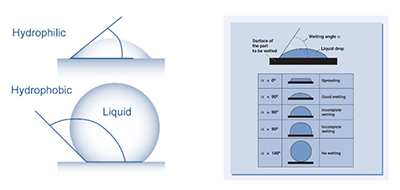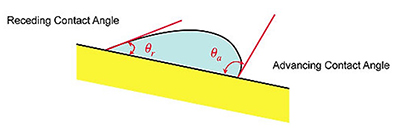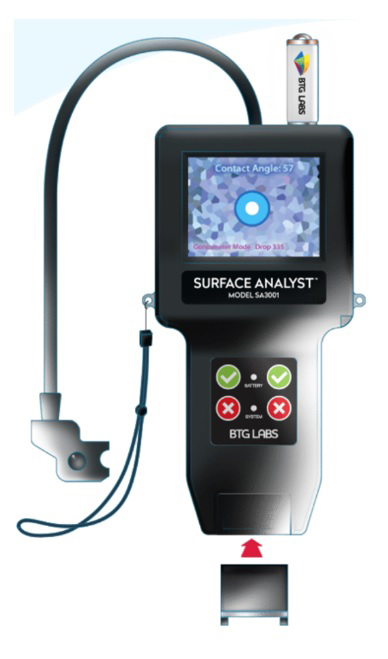Adhesion problems across the plastics industry are prolific. Bonding of 2D and 3D products, plastic-to-plastic, plastic-to-metal and plastic-to-composite, can be nearly impossible without pretreatment. However, pretreatments alone do not solve the problems without accurate measuring and understanding the surface conditions of the substrates. Many companies use dyne solutions for measuring surface energy. However, this test is subjective and often inaccurate. A new handheld test device provides data that enables users to troubleshoot adhesion problems. This article provides basic information about surface wetting/contact angles and features a new test device for inspecting polymer surface quality.
Understanding surface energy, wetting and contact angle
The underlying reasons why many plastics are difficult to bond are because they are non-wettable hydrophobic non-polar materials, chemically inert and possess poor surface wettability – i.e., low surface energy. Wetting out means the liquid flows and covers a surface to maximize the contact area and the attractive forces between the adhesive and adherend bonding surface. The higher the surface energy of the solid substrate relative to the surface tension of a liquid (water, printing inks, adhesives/encapsulation, coatings, etc.), the better will be its wettability and the smaller will be the contact angle. As a rule, acceptable bonding adhesion is achieved when the surface energy of a substrate is approximately eight to 10 dynes/cm greater than the surface tension of the liquid. See Figure 1.

For some applications it may only be necessary to examine the static equilibrium contact angle using dyne solutions. Dyne solutions can provide basic information, but they are not precise measurements of surface tension. Surface tension measurements can vary considerably by individual (technique) and the interpretation of the “center” liquid behavior. Dyne pens/solutions are known to be directional indicators of significant differences in the surface tension and capable of identifying good and bad bondable surfaces at economical pricing. Bottled dyne solutions (with wooden stem, cotton swap) can be preferable instead of pens because of contamination issues due to multiple usage.
Testing the fluid behavior of only the static contact angle can lead to misinterpretation of the liquid/solid interface results and the resolution of bonding problems. This is because industrial manufacturing production operations are more realistically dynamic conditions, not static. Thus, the dynamic contact angle (DCA) is important to understand. See Figure 2.

Contact angles generally are affected by both changes in surface chemistry and changes in surface topography. The advancing contact angle is most sensitive to the low-energy (unmodified) components of the substrate surface, while the receding angle is more sensitive to the high-energy, oxidized groups introduced by surface pretreatments. Thus, the receding angle actually is the measurement most characteristic of the modified component of the surface following pretreatments, as measured using dyne solutions. Therefore, it is important to measure both the advancing and receding contact angles on all surface-modified materials. When a droplet is attached to a solid surface and the solid surface is tilted, the droplet will lunge forward and slide downward. The angles formed are respectively termed the advancing angle (Θa) and the receding angle (Θr). ASTM D724 describes methods for measuring DCAs using advanced equipment (optical tensiometers and goniometers) to analyze advancing and receding contact angles based on drop shape analysis and mass.
For additional information pertaining to “Plasma Surface Pretreatments of Polymers for Improved Adhesion Bonding,” reference the April/May 2018 issue of Plastics Decorating.
New method for inspecting surface quality
The Surface AnalystTM 2001 is a handheld digital device for measuring contact angles in-line production without using chemical dyne solutions. The method is nondestructive; thus the part can be processed as usual – unlike dyne solution testing in which the part is scraped. Invented by BTG Labs, the Surface AnalystTM was engineered to put precision surface measurement technology in the hands of shop-floor technicians for operations where surface condition is critically important, such as adhesive bonding, painting, coating, printing and decontamination. See Photo 2.

Using a patented technique called “ballistic deposition,” the device deposits a highly purified drop of water on the substrate surface. By knowing the volume and area of a drop of water, the device then calculates the contact angle of the water against a given surface. The device provides immediate feedback to the user with a quantifiable number or a Pass/Fail alert. The inspection data provided by the device allows users to determine if the substrate has been properly prepared for adhesion processes, as a replacement for destructive dyne solutions. The handheld unit operates in any orientation and works on smooth or textured surfaces, such as grained TPOs. This data can be used for continuous process improvement, identifying quality drifts that may signal imminent problems or to pinpoint the critical cause of product failures. The Surface AnalystTM was developed with funding from the US Air Force with the original goal of controlling cost and quality in aerospace applications involving adhesive bonding of advanced materials.
Scott R. Sabreen is founder and president of The Sabreen Group, Inc., which is an engineering company specializing in secondary plastics manufacturing processes – surface pretreatments, adhesion bonding, decorating and finishing, laser marking/laser welding and product security. He has been developing new technologies and solving manufacturing problems for more than 30 years. Sabreen can be contacted at 972.820.6777 or by visiting www.sabreen.com or www.adhesionbonding.com.



